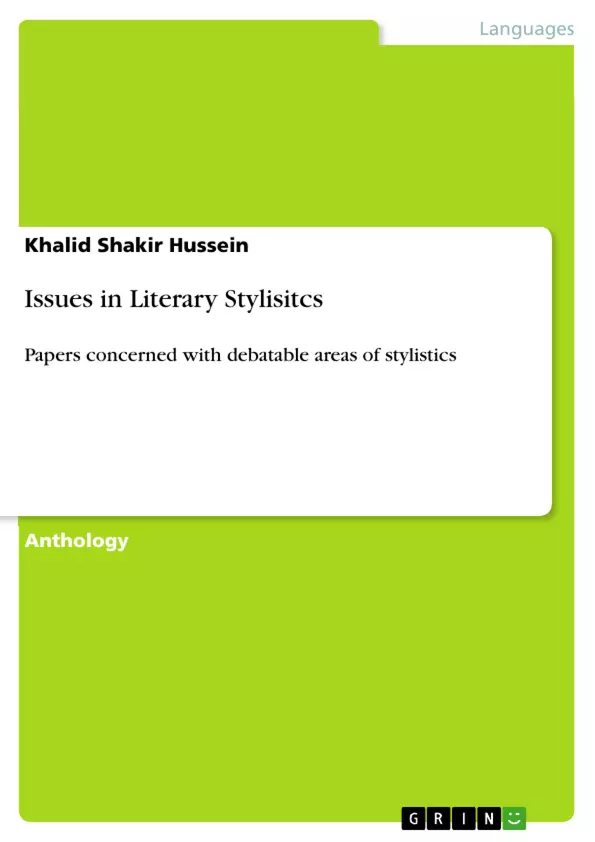A great deal has been published in and about the major issues in literary stylistics, but there has been no attempt, as far as I know, to provide a clear-cut guide to such issues for the students who are just embarking on their readings about such a rapidly developing and controversial field of study. This book aims at providing such students of Applied Linguistics with a collection of the author's research papers on different aspects of Literary Stylistics. Most of these papers have been published in different journals, and since these journals might be inaccessible to the students, this book comes to make such papers available to the targeted readers.
The collection is designed to meet the need of Applied Linguistics and Literary Stylistics majors by giving them a sort of familiarity with various topics in Literary Stylistics. It may also be used as a supplementary material for post-graduate students in Literary Stylistics.
Moreover, I hope that this book will be particularly a useful guide to help researchers navigate and appreciate the diverse, ever expanding and exciting landscape of Literary Stylistics. It is true that it incorporates different theoretical orientations and stylistic domains, yet achieves an overall coherence through the sequencing of papers: this sequencing is intended to address three major issues on "style":
1. style as deviation from a given expectation
2. style as choice
3. style as recurrence.
These three issues represent the most debatable linguistic definitions of 'style'. Style as deviation from a norm is particularly relevant to signal out one specific text from others and it has its great benefits in authorship attribution. Style as choice determines the linguistic system or repertoire from which the writer has made his stylistic choices. Style as recurrence investigates the co-occurrences of certain linguistic features that could be structural, lexical, etc., a matter which provides the researcher with an idea about the way the writer's language manifests its probabilistic nature.
There are three parts in the book, the first part has three papers given over to the first issue. The second goes on with other three papers dedicated to the second issue. The third exposes two papers related to the third issue. It is the author's stance that gives priority, in terms of the number of papers dedicated for each issue, to the first two issues over the third. I have tried to maintain a balance between the three issu
Table of Contents
- PART ONE: STYLE AS DEVIATION
- Levels of Linguistic Deviation in Faulkner's As I Lay Dying
- Foregrounding Through Parallelism and Deixis in Hemingway's Cat in the Rain
- Linguistic Foregrounding Through Internal Deviation
- PART TWO: STYLE AS CHOICE
- Phrase Structure- Transformational Analysis and the Concept of Style as Choice
- A Functional Analysis of the Nominal Group Structures, (Dylan Thomas' Poem There was a saviour As a Case Study)
- A Functional Analysis of Transitivity in Joyce's Eveline
- PART THREE: STYLE AS RECURRENCE
- Style As a Product of Three Structural Principles
- Sentence Length and complexity in Faulkner's The Bear
Objectives and Key Themes
This book aims to provide students of Applied Linguistics with a collection of research papers on different aspects of Literary Stylistics. It focuses on various topics within the field, aiming to provide familiarity with different approaches and perspectives. It also serves as a supplementary material for post-graduate students. The book aims to guide researchers in navigating and appreciating the diverse landscape of Literary Stylistics.- Style as deviation from a given expectation
- Style as choice
- Style as recurrence
- Linguistic features and their contribution to style
- Authorial style and its analysis
Chapter Summaries
PART ONE: STYLE AS DEVIATION
- Chapter 1 examines the levels of linguistic deviation found in Faulkner's As I Lay Dying, focusing on how deviation from expected norms creates a unique stylistic effect.
- Chapter 2 explores the use of parallelism and deixis in Hemingway's Cat in the Rain to achieve foregrounding, a stylistic device that draws attention to specific linguistic elements.
- Chapter 3 analyzes internal deviation, a type of foregrounding that occurs within a text, highlighting its role in creating stylistic prominence.
PART TWO: STYLE AS CHOICE
- Chapter 4 delves into the concept of style as choice, using phrase structure-transformational analysis to understand how writers make stylistic decisions.
- Chapter 5 presents a functional analysis of nominal group structures in Dylan Thomas' poem "There was a saviour", exploring how stylistic choices are made within grammatical structures.
- Chapter 6 examines the concept of transitivity in Joyce's Eveline, demonstrating how grammatical choices contribute to the text's overall style and meaning.
Keywords
Literary stylistics, style, deviation, choice, recurrence, foregrounding, parallelism, deixis, internal deviation, phrase structure-transformational analysis, functional analysis, nominal group structures, transitivity, authorship attribution, linguistic features, authorial style.- Citation du texte
- Khalid Shakir Hussein (Auteur), 2014, Issues in Literary Stylisitcs, Munich, GRIN Verlag, https://www.grin.com/document/273823



